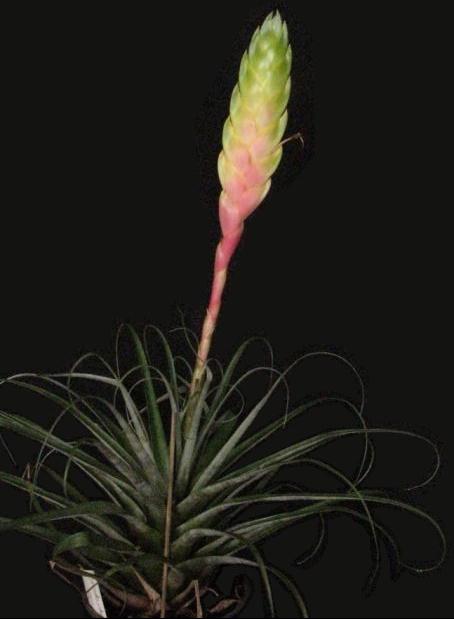
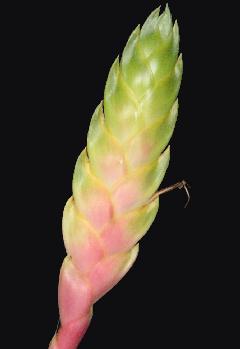
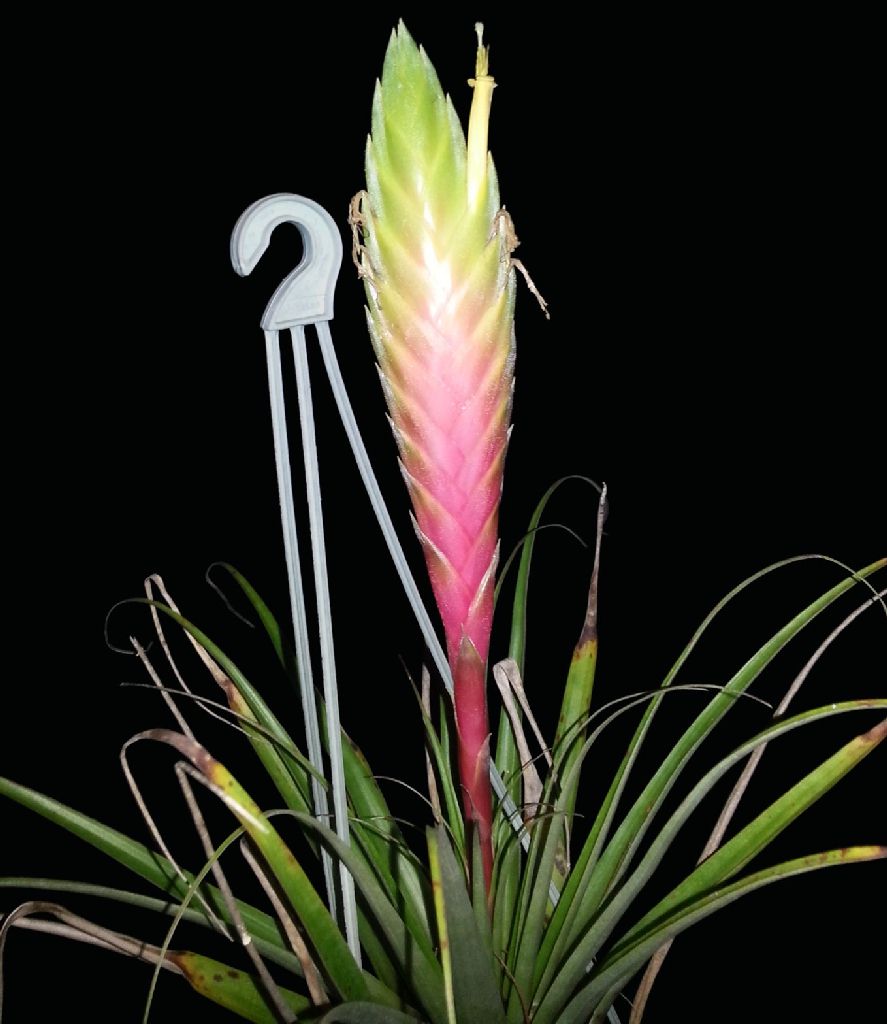
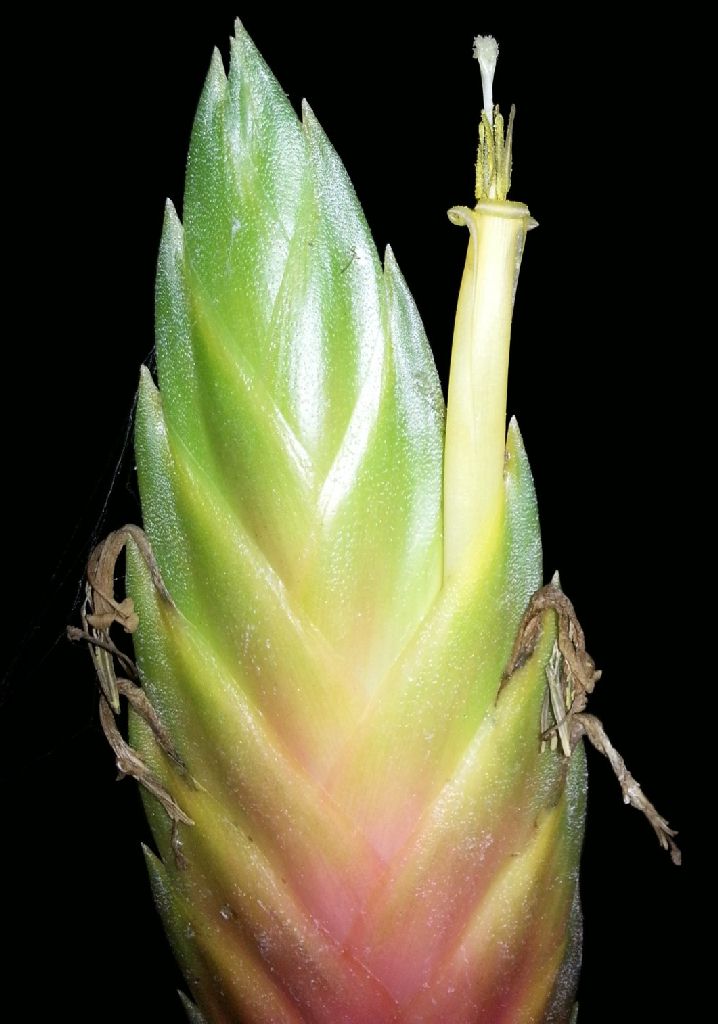
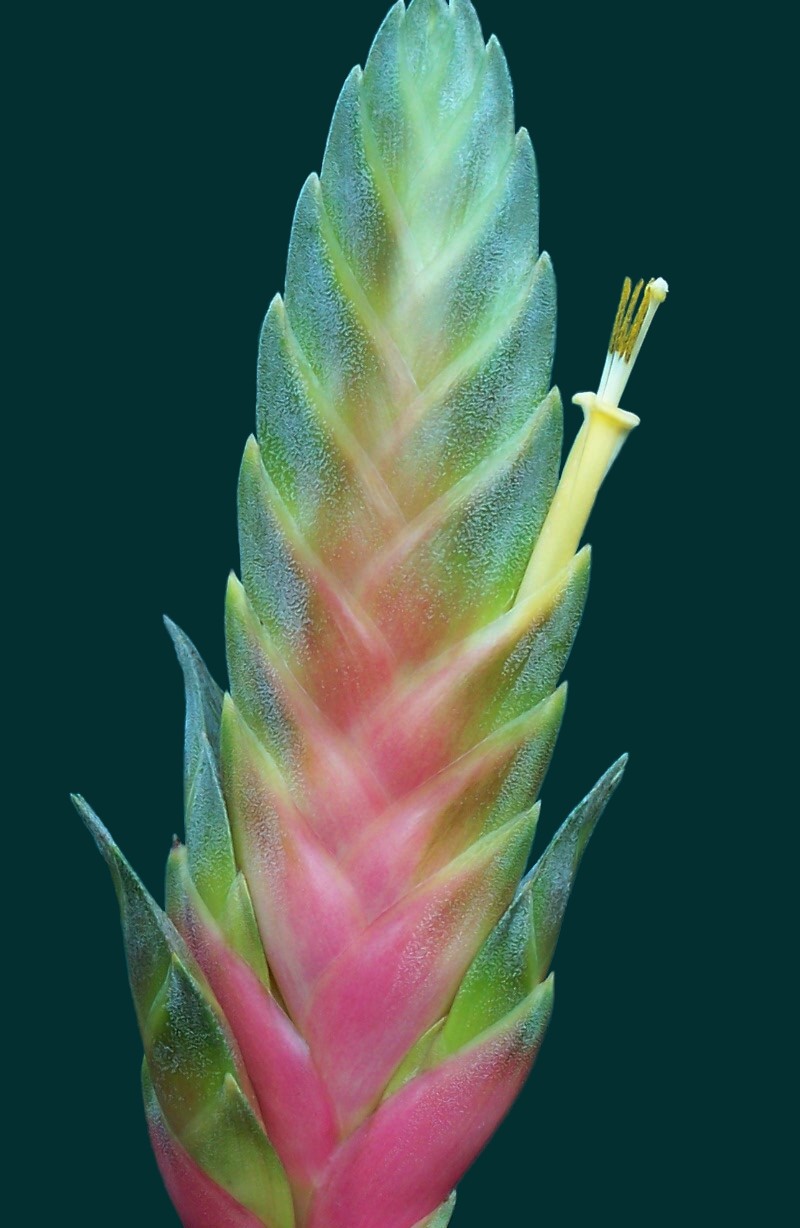

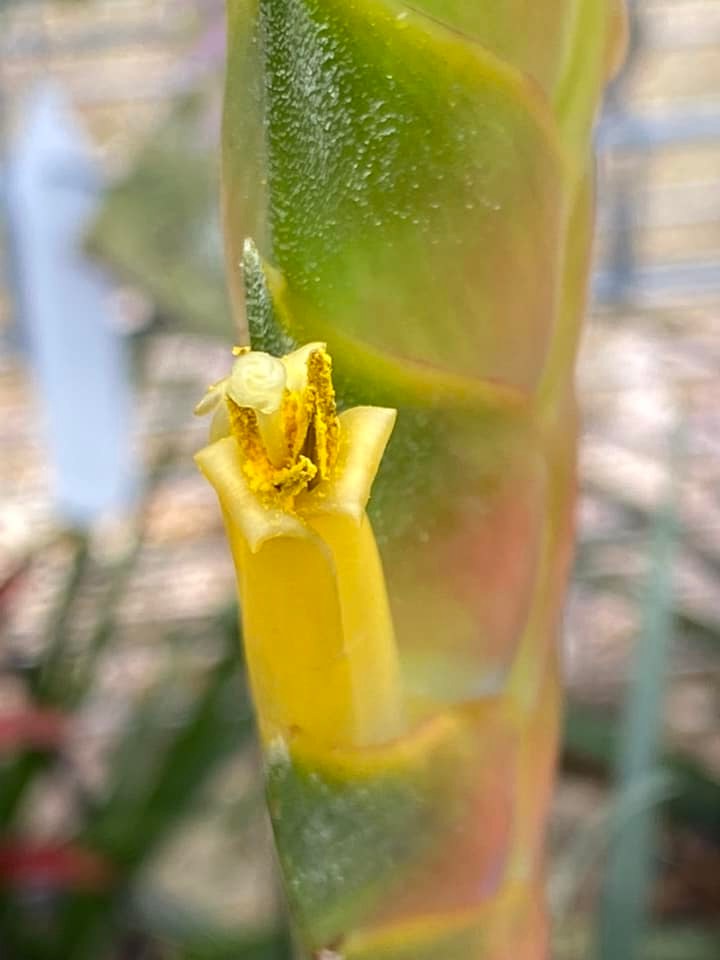
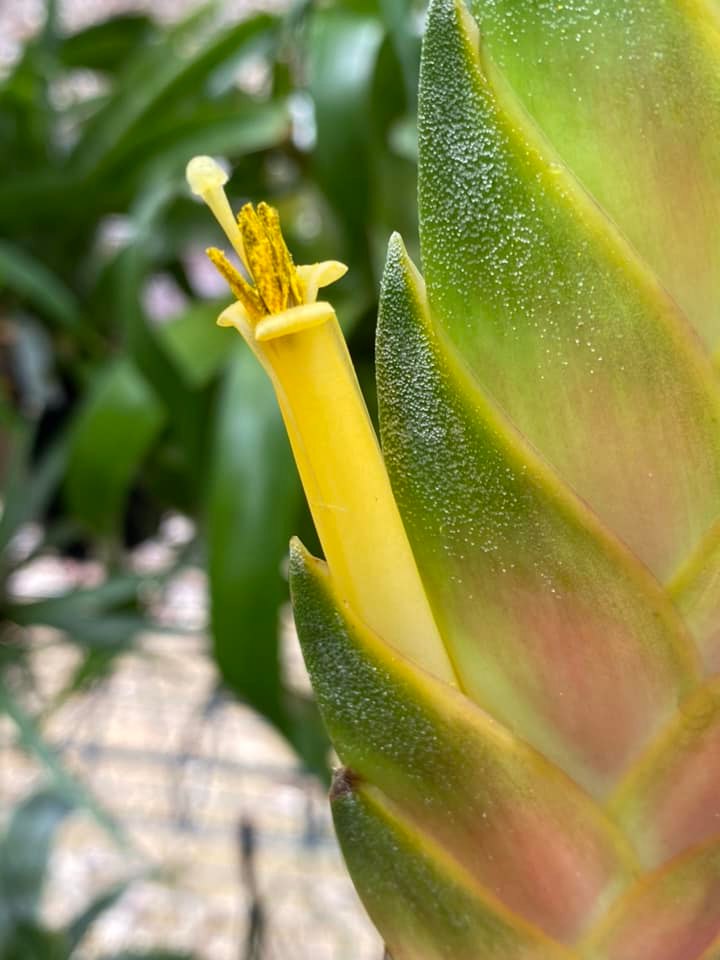
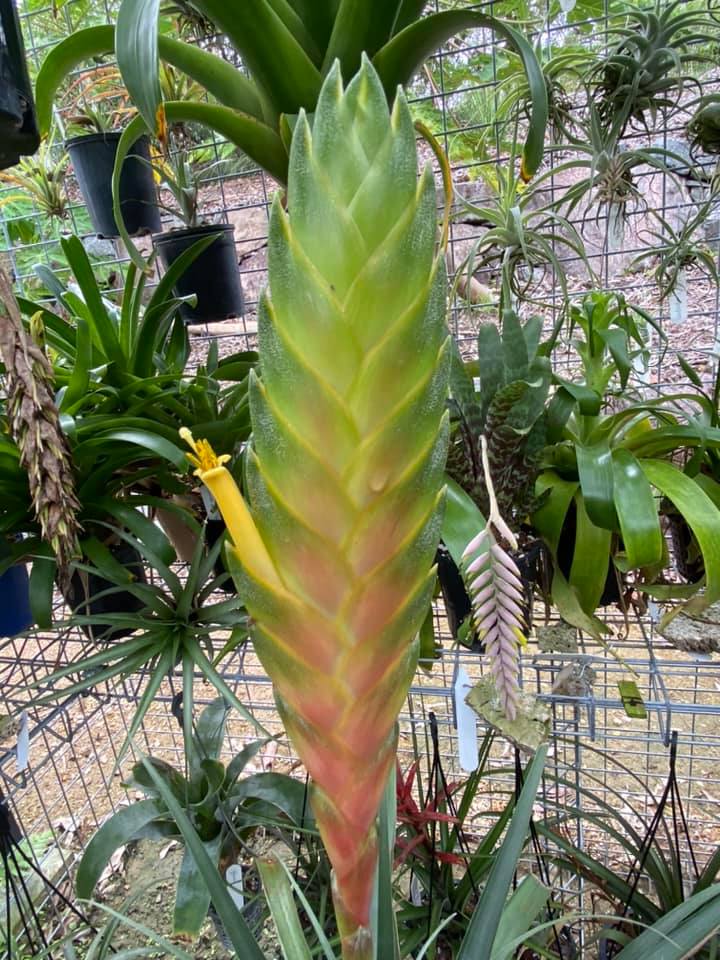

Tillandsia lampropoda L. B. Smith in Yuncker, Field Mus. Publ. Bot. 17: 320, pl. 9. 1938.
Acaulis, ad 43 cm. alta; foliis multis, substrictis, anguste cyathiformi-rosulatis, inflorescentiam subaequantibus; vaginis oblongo-ellipticis, 1 dm. Iongis, dense obscureque punctulatis, fulgide purpureis; laminis angustissime triangularibus, caudato-acuminatis, base 15-20 mm. latis, densissime adpresseque cinereo-lepidotis; scapo erecto, 6 mm. diametro, glabro; scapi bracteis erectis, imbricatis, late ovatis, apiculatis vel infimis anguste caudato-laminatis, perobscure punctulatis, laevibus, lucidis, vivo rubris; inflorescentia simplicissima, elliptica., acuta, valde complanata, 15 cm. longa, 7 cm. lata; bracteis florigeris distichis, dense imbricatis, quam internodia 8-plo longiori-bus, late ovatis, acutis, 5 cm. longis, 4 cm. latis, valde carinatis, coriaceis, laevibus, lucidis, perobscure punctulatis, ad apicem versus cinereo-lepidotis, apice citrinis, base rubris, anguste atro-marginatis; floribus solum imperfecte cognitis, subsessilibus; sepalis anguste lanceolatis, acutis, 32 mm. longis, carinatis, coriaceis, nervatis, glabris, liberis; petalis ca. 5 cm. longis; stylo elongato.
HONDURAS: Comayagua: On tree near El Achote, above the plains of Siguatepeque, alt. 1,350 meters, 1936, Yuncker, Dawson & Youse 5895 (Herb. Gray, type).
It is not possible to see whether the stamens are exserted or not, but the style is much too long for the section Phytarrhiza. Consequently it must belong to either Platystachys or Allardtia, and I am inclined to feel that it is probably the latter. In habit T. lampropoda resembles the larger varieties of T. fasciculata, but the purple leaf sheaths and lustrous, mostly apiculate scape bracts readily distinguish it. Also in T. fasciculata the scales are uniform and completely cover the sheath and blade, while in T. lampropoda there is an abrupt transition from the inconspicuous, separated, punctiform scales of the sheath to the much larger, overlapping ones of the blade.
Desc from S&D p944-6
Plant stemless, 4-6 dm high.
Leaves many, substrict, forming a slenderly cyathiform rosette;
Sheaths oblong-elliptic, 1dm long, densely and obscurely punctulate-lepidote, bright-purple;
Blades very narrowly triangular, caudate-attenuate, very densely appressed-cinereous-lepidote.
Scape erect, 6 mm in diameter, glabrous;
Scape-bracts erect, imbricate, broadly ovate, apiculate or the lowest narrowly caudate-laminate, subinflated, very obscurely punctulate, even, shining, red when living. Inflorescence simple or digitate;
Spikes elliptic, acute, strongly complanate.
Floral bracts distichous, densely imbricate, 8 times as long as the internodes, broadly ovate, acute, 5 cm long, 4 cm wide, strongly carinate, coriaceous, even, shining, very obscurely punctulate, cinereous-lepidote toward apex, yellow toward the apex, shading into red toward the base, narrowly dark-margined;
Flowers subsessile.
Sepals narrowly lanceolate, acute, 32 mm long, carinate, coriaceous, nerved, glabrous, free;
Petals about 5 cm long, yellow;
Stamens exserted.
Tillandsia lampropoda var lampropoda
Flowering 4-5 dm high.
Leaves to 5 dm long;
Blades 15-20 mm wide.
Inflorescence simple, 13-17 cm long, 6 cm wide.
Type. Yuncker, Dawson & Youse 5895 (holotype GH), El Achote above Siguatepeque, 1350 m alt, Comayagua, Honduras, 15 Jul 1936.
DISTRIBUTION. Epiphytic in woods, 1300-2000 m alt, southern Mexico to Costa Rica. MEXICO. CHIAPAS: Los Lagos, southeast of Comitan, 15-20 Apr 1949, Carlson 1930 (F); Comitan to Monte Bello, May 1952, Moore 6346-C (BH, US); Bravo 2 (MEXU, US); Jitotol, 1959, Van Hyning 5933 (US); Koltol Te, Tenejapa, 10 Jul 1964, Breedlove 6165 (DS); Lago Monte Bello, La Trinitaria, 14 Apr 1965, Breedlove 9769 (DS, US). GUATEMALA. HUEHUETENANGO: Xoxlac to Nucapuxlac, Sierra de los Cuchumatanes, 17 Ju11942, Steyermark 48964 (F). ALTA VERAPAZ: Tactic, 10 Apr 1941, Standley 92019 (F); 14 Apr 1941, 92344 (F); 20 Feb 1942, Steyermark 44004 (F, US); San Cristobal, 23 Mar 1946, Carlsan s n (F). BAJA VERAPAZ: Santa Rosa, 30 Mar 1939, Standley 69778 (F). QUEZALTENANGO: Mujulia, San Martin Chile Verde to Colornba, 1 Feb 1941, Standley 85532 (F). ZACAPA: Cerro de Monos to Monte Virgen, 17 Jan 1942, Steyermark 42890 (F). SUCHITEPEQUEZ: Lorna Grande, Volcan Santa Clara, 2 Jun 1942, Steyermark 46839 (F). HONDURAS. MORAZAN: Piedra Herrada, ca. 14° N, 87° W, 11 Sep 1949, L. 0. Williams 15999 (US); Quebrada Honda, Las Tablas to Lepaterique, 31 Mar 1957, Malina 7819 {US); Zarnorano, 4 Ju11964, Gilmartin 944 (US); 14 Ju11964, 982 (US). SALVADOR. SANTA ANA: Hacienda Los Planes, 24 Feb 1951, Rohweder 83-84, 86-87 (HBG); 85 (Z); 7 Jun 1951, 88, 90 (HBG); 25 Aug 1951, 91 (B). NICARAGUA. MATAGALPA: Cordillera Central, Matagalpa to Jinotega, 15 Jan 1963, L.O. Williams et al. 23908 (F). COSTA RICA, CARTAGO: Pacayas, cult Montreal Jan 1962, Horich s n (US).
Til1andsia lampropoda L. B. Smith var major L. B. Smith, Phytologia 10: 483. 1964,
Plant flowering over 6 dm high.
Leaves ca. 8 dm long;
Blades 3 cm wide.
Scape-bracts subinflated with the lowest subfoliaceous, the highest apiculate, Inflorescence digitate from 3 spikes;
Primary bracts like the upper scape-bracts, very broadly ovate, 5 cm long;
Spikes lanceolate, strongly complanate, 13-19 cm long.
Floral bracts vermilion with green tips;
Petals white.
Type, Wyly M. Billing, Jr. 55 (holotype US), without locality, Guatemala, cultivated 1964.
DISTRIBUTION. Known from the type locality only.
A Possible variation of Tillandsia lampropoda from Chiapas, Mexico by Robert Guess and Virginia Guess in Journ Brom Soc 53(2): 67-69. 2003
So little is known about Tillandsia lampropoda L.B. Sm. var. major L.B. Sm., that J.E Utley (1994) includes it in a list of questionable tillandsias reported from Mesoamerica. He places it in this dubious category because the original description of the variety was made on cultivated material known only from a single plant. Thus was our amazement when a long-time Maya associate presented us with an unusual tillandsia a few days before Christmas 2002. Recognizing it as different from any bromeliad he had ever seen in the forests, he was as proud of this beautiful flowering plant as we were pleased to see it.
He came upon it during an annual trek he makes with his companeros to gather Tillandsia eizii L.B. Sm. for ceremonial use in the indigenous highland community of San Juan Chamula. Each year these Maya search the forests for this endemic bromeliad they prize above most others to decorate the altars of their santos during the Christmas season. On this particular day, in addition to finding the prescribed numbers of T. eizii, our associate collected two unusual tillandsias growing side by side in an oak tree: one in full flower and the other a maturing plant. After carefully examining the tillandsia, we conclude that it could well be the relatively unknown, "white flowered" T. lampropoda var major.
Although the body of this epiphytic plant resembles Tillandsia lampropoda L.B. Sm., it markedly contrasts with it in overall size, as well as in the shape and the color of the inflorescence and flowers. Like T. lampropoda, the narrow, triangular leaves form an upright rosette, and end in graceful arching tips similar to the long foliaceous scape bracts. It measures 90 cm in flower, with leaves up to 70 cm long. One of the most striking characteristics is the rich, aubergine purple color of the sheaths, both adaxially and abaxially. The red inflorescence is digitate with six spikes ranging in size from 13 to 20 cm long and 5 cm wide. The flowers, erect with pedicels measuring 0.6 cm, produce copious exudate, have yellow-white petals that are 8 cm long with bluish hues on the edges. The stamens are exserted. Because of the scanty descriptive material available on this variety, we can only surmise that the plant could well be T. lampropoda var. major first reported from Guatemala in 1964 (Smith and Downs 1977).
It is quite feasible for this variety of Tillandsia lampropoda to occur in Chiapas, as the topography and physical environment of the state are closely related to that of Guatemala (West 1964). Since Chiapas was a province of Guatemala during the colonial era that ended with independence from Spain in 1827, the border that separates the two regions today is more political than natural. The limestone Central Plateau that begins near San Cristobal de Las Casas, Chiapas, is part of the highlands of Northern Central America, a continuous strand of mountains that extends into central Guatemala including the Altos Cuchumatanes and the mountain ranges of Alta Verapaz. Large stands of oak and pine trees comprise the typical vegetation at elevations between 1000 and 2000 m with evergreen hardwood cloud forests above the 2000 m level.
Although vast sections of the forests in Guatemala near the border with Chiapas have been destroyed, some still remain in Chiapas.
The collection site of the plant described here, in oak-pine forests 10 km west-southwest of Chanal, was at 2050 m in elevation and some 60 km from San Cristobal in the Central Plateau of Chiapas. Although this region is still sparsely populated, small hamlets, agricultural plots, and lumbering projects are slowly infringing on the once dense forests. Upon our own investigation of the area, we were unable to locate other flowering examples of the described variety.The forest, however, does support populations of Tillandsia eizii, T. lampropoda L.B. Sm., T. carlsoniae L.B. Sm., T butzii Mez, T. seleriana Mez, and T. vicentina Standley var. glabra, which, according to Luther (2002), is synonymous with T. vicentina Standley var wuelfinghoffii.
The plant herein noted, however, does not appear to be a natural hybrid of any of these species.
Such serendipitous discoveries verify the potential that remains in Chiapas for more long-term study of Bromeliaceae. At least fifteen genera are now known to grow in Chiapas including several species of Werauhia and Racinaea. In 1974, Beutelspacher and Beutelspacher added 37 species to the 52 previously documented by Eizi Matuda in 1952. Since then, several new species of tillandsias have been identified.
Perhaps this report of what might be Tillandsia lampropoda var. major may lure a few investigators to either confirm our conclusion, describe it as another variety, or determine it to be a new species of Tillandsia {Harry Luther of the Bromeliad Identification Center, suggests that the plant in question may be a natural hybrid between T. lampropoda and T. vicentina.}